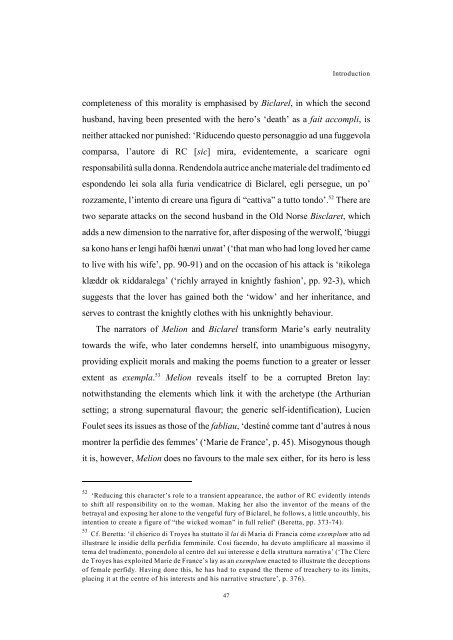Melion and Biclarel - University of Liverpool
Melion and Biclarel - University of Liverpool
Melion and Biclarel - University of Liverpool
Create successful ePaper yourself
Turn your PDF publications into a flip-book with our unique Google optimized e-Paper software.
Introduction<br />
completeness <strong>of</strong> this morality is emphasised by <strong>Biclarel</strong>, in which the second<br />
husb<strong>and</strong>, having been presented with the hero’s ‘death’ as a fait accompli, is<br />
neither attacked nor punished: ‘Riducendo questo personaggio ad una fuggevola<br />
comparsa, l’autore di RC [sic] mira, evidentemente, a scaricare ogni<br />
responsabilità sulla donna. Rendendola autrice anche materiale del tradimento ed<br />
espondendo lei sola alla furia vendicatrice di <strong>Biclarel</strong>, egli persegue, un po’<br />
52<br />
rozzamente, l’intento di creare una figura di “cattiva” a tutto tondo’. There are<br />
two separate attacks on the second husb<strong>and</strong> in the Old Norse Bisclaret, which<br />
adds a new dimension to the narrative for, after disposing <strong>of</strong> the werwolf, ‘biuggi<br />
sa kono hans er lengi hafði hænni unnat’ (‘that man who had long loved her came<br />
to live with his wife’, pp. 90-91) <strong>and</strong> on the occasion <strong>of</strong> his attack is ‘Rikolega<br />
klæddr ok Riddaralega’ (‘richly arrayed in knightly fashion’, pp. 92-3), which<br />
suggests that the lover has gained both the ‘widow’ <strong>and</strong> her inheritance, <strong>and</strong><br />
serves to contrast the knightly clothes with his unknightly behaviour.<br />
The narrators <strong>of</strong> <strong>Melion</strong> <strong>and</strong> <strong>Biclarel</strong> transform Marie’s early neutrality<br />
towards the wife, who later condemns herself, into unambiguous misogyny,<br />
providing explicit morals <strong>and</strong> making the poems function to a greater or lesser<br />
53<br />
extent as exempla. <strong>Melion</strong> reveals itself to be a corrupted Breton lay:<br />
notwithst<strong>and</strong>ing the elements which link it with the archetype (the Arthurian<br />
setting; a strong supernatural flavour; the generic self-identification), Lucien<br />
Foulet sees its issues as those <strong>of</strong> the fabliau, ‘destiné comme tant d’autres à nous<br />
montrer la perfidie des femmes’ (‘Marie de France’, p. 45). Misogynous though<br />
it is, however, <strong>Melion</strong> does no favours to the male sex either, for its hero is less<br />
52<br />
‘Reducing this character’s role to a transient appearance, the author <strong>of</strong> RC evidently intends<br />
to shift all responsibility on to the woman. Making her also the inventor <strong>of</strong> the means <strong>of</strong> the<br />
betrayal <strong>and</strong> exposing her alone to the vengeful fury <strong>of</strong> <strong>Biclarel</strong>, he follows, a little uncouthly, his<br />
intention to create a figure <strong>of</strong> “the wicked woman” in full relief’ (Beretta, pp. 373-74).<br />
53<br />
Cf. Beretta: ‘il chierico di Troyes ha stuttato il lai di Maria di Francia come exemplum atto ad<br />
illustrare le insidie della perfidia femminile. Così facendo, ha devuto amplificare al massimo il<br />
tema del tradimento, ponendolo al centro del sui interesse e della struttura narrativa’ (‘The Clerc<br />
de Troyes has exploited Marie de France’s lay as an exemplum enacted to illustrate the deceptions<br />
<strong>of</strong> female perfidy. Having done this, he has had to exp<strong>and</strong> the theme <strong>of</strong> treachery to its limits,<br />
placing it at the centre <strong>of</strong> his interests <strong>and</strong> his narrative structure’, p. 376).<br />
47
















